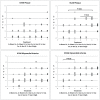Darbepoetin alpha reduces oxidative stress and chronic inflammation in atherosclerotic lesions of apo E deficient mice in experimental renal failure
- PMID: 24586350
- PMCID: PMC3938414
- DOI: 10.1371/journal.pone.0088601
Darbepoetin alpha reduces oxidative stress and chronic inflammation in atherosclerotic lesions of apo E deficient mice in experimental renal failure
Abstract
Background: Cardiovascular morbidity and mortality is very important in patients with chronic renal failure. This occurs even in mild impairment of renal function and may be related to oxidative stress and chronic inflammation. The nephrectomized apo E knockout mouse is an accepted model for evaluating atherosclerosis in renal dysfunction. Erythropoietin derivates showed anti-oxidative and anti-inflammatory effects. Therefore, this study evaluates the effects of Darbepoetin on markers of oxidative stress and chronic inflammation in atherosclerotic lesions in apo E knockout mice with renal dysfunction.
Methods: Apo E knockout mice underwent unilateral (Unx, n = 20) or subtotal (Snx, n = 26) nephrectomy or sham operation (Sham, n = 16). Mice of each group were either treated with Darbepoetin or saline solution, a part of Snx mice received a tenfold higher dose of Darbepoetin. The aortic plaques were measured and morphologically characterized. Additional immunhistochemical analyses were performed on tissue samples taken from the heart and the aorta.
Results: Both Unx and Snx mice showed increased expression of markers of oxidative stress and chronic inflammation. While aortic plaque size was not different, Snx mice showed advanced plaque stages when compared to Unx mice. Darbepoetin treatment elevated hematocrit and lowered Nitrotyrosin as one marker of oxidative stress, inflammation in heart and aorta, plaque stage and in the high dose even plaque cholesterol content. In contrast, there was no influence of Darbepoetin on aortic plaque size; high dose Darbepoetin treatment resulted in elevated renal serum parameters.
Conclusion: Darbepoetin showed some protective cardiovascular effects irrespective of renal function, i.e. it improved plaque structure and reduced some signs of oxidative stress and chronic inflammation without affecting plaque size. Nevertheless, the dose dependent adverse effects must be considered as high Darbepoetin treatment elevated serum urea. Elevation of hematocrit might be a favorable effect in anemic Snx animals but a thrombogenic risk in Sham animals.
Conflict of interest statement
Figures






Similar articles
-
Effects of long- and short-term darbepoetin-α treatment on oxidative stress, inflammation and endothelial injury in ApoE knockout mice.Adv Clin Exp Med. 2017 Jul;26(4):635-643. doi: 10.17219/acem/62834. Adv Clin Exp Med. 2017. PMID: 28691421
-
The apolipoprotein e knockout mouse: a model documenting accelerated atherogenesis in uremia.J Am Soc Nephrol. 2003 Feb;14(2):311-6. doi: 10.1097/01.asn.0000045048.71975.fc. J Am Soc Nephrol. 2003. PMID: 12538731
-
Proteomic profiling during atherosclerosis progression using SELDI-TOF-MS: effect of darbepoetin treatment.Acta Histochem. 2010 Sep;112(5):432-43. doi: 10.1016/j.acthis.2009.04.003. Epub 2009 Jun 4. Acta Histochem. 2010. PMID: 19500820
-
Darbepoetin alfa: a novel erythropoiesis-stimulating protein.Drugs Today (Barc). 2003 Jul;39(7):477-95. doi: 10.1358/dot.2003.39.7.799441. Drugs Today (Barc). 2003. PMID: 12973399 Review.
-
Inflammation, Oxidative Stress, Senescence in Atherosclerosis: Thioredoxine-1 as an Emerging Therapeutic Target.Int J Mol Sci. 2021 Dec 22;23(1):77. doi: 10.3390/ijms23010077. Int J Mol Sci. 2021. PMID: 35008500 Free PMC article. Review.
Cited by
-
Role of Erythropoiesis-Stimulating Agents in Cardiovascular Protection in CKD Patients: Reappraisal of Their Impact and Mechanisms.Cardiovasc Drugs Ther. 2023 Dec;37(6):1175-1192. doi: 10.1007/s10557-022-07321-3. Epub 2022 Feb 12. Cardiovasc Drugs Ther. 2023. PMID: 35150385 Review.
-
Possible Inhibitory Effect of Erythropoiesis-Stimulating Agents at the Predialysis Stage on Early-Phase Coronary Events after Hemodialysis Initiation.Cardiorenal Med. 2016 Nov;7(1):21-30. doi: 10.1159/000448009. Epub 2016 Aug 12. Cardiorenal Med. 2016. PMID: 27994599 Free PMC article.
-
Peritoneal Dialysis Aggravates and Accelerates Atherosclerosis in Uremic ApoE-/- Mice.J Am Heart Assoc. 2024 Jul 16;13(14):e034066. doi: 10.1161/JAHA.123.034066. Epub 2024 Jul 9. J Am Heart Assoc. 2024. PMID: 38979792 Free PMC article.
References
-
- U.S. Renal Data System (2007) USRDS annual report 2007 : Atlas of Chronic Kidney Disease and Endstage Renal Diseases in the USA. National Institutes of Health, National Institute of Diabetes and Digestive and Kidney Diseases, Bethesda, MD.
-
- Collins AJ (2003) Cardiovascular mortality in end-stage renal disease. Am J Med Sci 325: 163–167. - PubMed
-
- Jungers P, Massy ZA, Nguyen Khoa T, Fumeron C, Labrunie M, et al. (1997) Incidence and risk factors of atherosclerotic cardiovascular accidents in predialysis chronic renal failure patients: a prospective study. Nephrol Dial Transplant 12: 2597–2602. - PubMed
-
- Iseki K, Fukiyama K (2000) Long-term prognosis and incidence of acute myocardial infarction in patients on chronic hemodialysis. The Okinawa Dialysis Study Group. Am J Kidney Dis 36: 820–825. - PubMed
-
- Anavekar NS, McMurray JJ, Velazquez EJ, Solomon SD, Kober L, et al. (2004) Relation between renal dysfunction and cardiovascular outcomes after myocardial infarction. N Engl J Med 351: 1285–1295. - PubMed
Publication types
MeSH terms
Substances
LinkOut - more resources
Full Text Sources
Other Literature Sources
Medical
Miscellaneous

